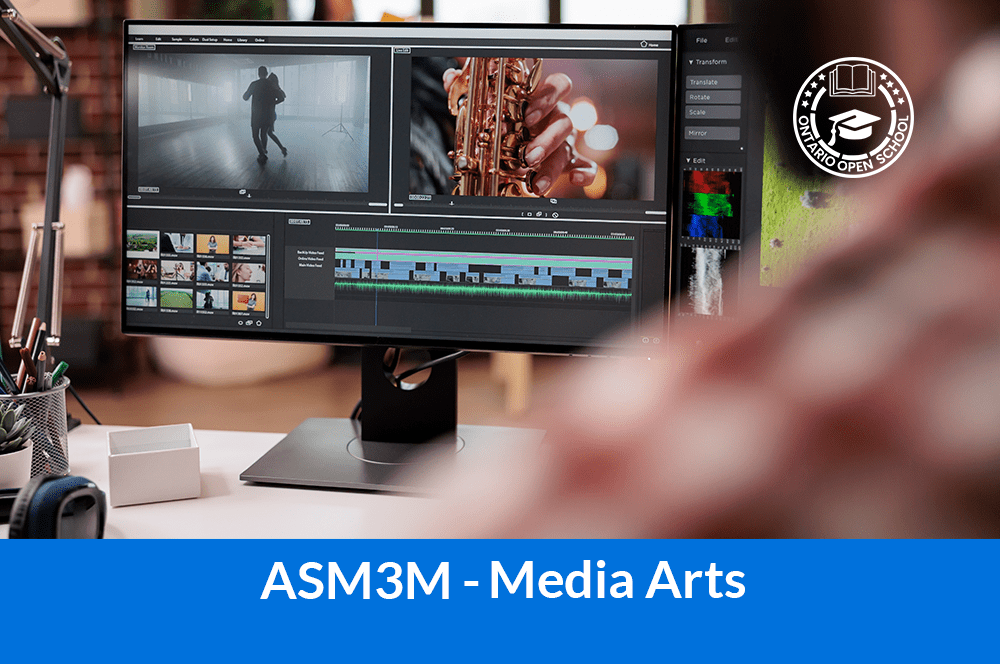- info@ontarioopenschool.com
- 647-494-4499
-
Unit 100 - 29 Gervais Drive, North York, ON.
M3C 1Y9
Copyright 2024 Ontario Open School Inc. All Rights Reserved.
This course focuses on the development of media arts skills through the production of art works involving traditional and emerging technologies, tools, and techniques such as new media, computer animation, and web environments. Students will explore the evolution of media arts as an extension of traditional art forms, use the creative process to produce effective media art works, and critically analyze the unique characteristics of this art form. Students will examine the role of media artists in shaping audience perceptions of identity, culture, and values.
Unit Order | Unit Name | Suggested Time |
|---|---|---|
| Unit 1 | Camera Basics This unit focuses on learning about SLR and DSLR Cameras. Exposure, Aperture, Depth of field and ISO How they work and differ from DSLR. Students develop creative skills and achieve artistic growth through the study of both traditional film photography and digital photography, as an expressive art form. | 27 hours |
| Unit 2 | Hybrid Art In this unit you will learn about Hybridity. The elements that help us to create a hybrid art. What is the goal of a Hybrid Artist. Then you will create your own piece of Hybrid. They will explore to make their own hybrid art. | 27 hours |
| Unit 3 | Duration art The Duration or Endurance Art is based on time as it is clear from its name. The type of art which depends on time, space, audiences and the tolerance of the artist in some cases. They will learn about performance art and all other interactive new media | 27 hours |
| Unit 4 | Interactive and Animation Student will review and learn the History of animation and stop motion as well as interactive art. They practice to make their own stop motion and use Photoshop to edit their work | 27 hours |
| Final Evaluation 30% | Final Project Finl Exam | 8 hours 2 hours |
| Total | 110 hours |
A wide variety of instructional strategies are used to provide learning opportunities to accommodate a variety of learning styles, interests and ability levels. These strategies include, but are not limited to:
PPT/PDF Lessons
Audio/Video Lectures
YouTube / TedTalk /Media Analysis
Individual Presentations
Independent Studies
Learning Logs
Discussions
Directed Reading/ Thinking and Writing Activities
Conferences
Modelling
Think/Pair/Share
Brainstorming
Conferences Observations Portfolio
Graphic organizers
Purpose
The primary purpose of assessment is to improve student learning. Assessment relates directly to the expectations for the course.
A variety of assessments for and as learning are conducted on a regular basis to allow ample opportunities for students to improve and ultimately demonstrate their full range of learning and for the teacher to gather information to provide feedback. Assessment tasks relate to the success criteria set out in lesson plans. Success criteria allow students to see what quality looks like.
Evaluation is the process of judging the quality of student work in relation to the achievement chart categories and criteria and assigning a percentage grade to represent that quality. Evaluation is based on gathering evidence of student achievement through:
Assessment for Learning – we provide feedback and coaching. Assessment FOR Learning is the process of seeking and interpreting evidence for the use of learners and their teachers to decide where the learners are in their learning, where they need to go, and how best to go there.
Assessment as Learning – we help students monitor progress, set goals, reflect on their learning
Assessment AS Learning is the process of the explicit fostering of students’ capacity over time to be their own best assessors, but teachers need to start by presenting and modeling external, structured opportunities for students to assess themselves.
Assessment of Learning – we use assessments to provide evaluative statements about student achievement. Assessment OF Learning is the assessment that becomes public and results in statements of symbols
(marks/grades/levels of achievement) about how well students are learning. It often contributes to pivotal decisions that will affect students’ future.
ASSESSMENT TOOLS
| Assessment and evaluation in this course will be continuous throughout the term and will include a variety of methods. | ||
| Assessment As Learning | Assessment For Learning | Assessment Of Learning |
|
Student Product: Learning Logs KWL Chart
|
Student Product:
Assigned Questions / Worksheet/ Homework Diagnostic Quiz |
Student Product: Unit Culminating Activities Unit Tests Independent Study Project Final Exam |
|
Observation: Self-Monitoring |
Observation:
Group and Individual Presentation
|
Observation: PowerPoint / Poster/ Media Presentation
|
|
Conversation: Reflective Discussion and Online Communication |
Conversation:
Student Teacher Conferences Q/A Session Online Communication
|
Conversation: Student- Teacher Conferencing |
Resources
Growing Success: Assessment, Evaluation and Reporting in Ontario Schools (2010)
http://www.edu.gov.on.ca/eng/policyfunding/growSuccess.pdf
Grading
Weighting of categories
| Knowledge/Understanding | Thinking/Inquiry | Communication | Application |
| 25% | 25% | 25% | 25% |

Course Grade | Grade 11 |
|---|---|
Course Code | ASM3M |
Course Category | Arts |
Course Type | University/College Preparation |
Course Delivery | Online |
Course Duration | 110h |
Course Credit | 1.00 |
Copyright 2024 Ontario Open School Inc. All Rights Reserved.